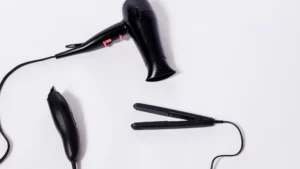Hair follicle regeneration is at the forefront of innovative solutions for hair loss, offering hope to millions who struggle with thinning hair or one-sided hair loss.
My name is Emma Wright, your resident hair restoration specialist. Today we’ll be discussing what exactly hair follicle regeneration is?, and how does it play a crucial role in modern hair loss treatments?
This article delves into the biological processes that drive hair growth and how they are leveraged to restore a full, healthy head of hair.
Understanding Hair Follicle Regeneration
Hair follicle regeneration refers to the natural process where hair follicles, the small structures in the skin responsible for hair production, are renewed and rejuvenated.
This biological phenomenon is critical in maintaining the hair cycle, which includes growth (anagen phase), rest (telogen phase), and shedding (catagen phase). Hair follicle regeneration ensures that after each cycle, a new hair strand emerges, replacing the one that has fallen out.
The capacity for hair follicle regeneration varies from person to person and is influenced by factors such as genetics, age, and health. In cases of hair loss or thinning, this regenerative process can become impaired, leading to fewer hair follicles entering the growth phase. This is where the science of hair follicle regeneration becomes vital in hair transplant for long hair procedures.
The Biological Processes Involved in Hair Follicle Regeneration
The process of hair follicle regeneration is complex and involves several stages, each regulated by various cellular and molecular mechanisms. At the heart of this process are stem cells, which are located in the hair follicle’s bulge area. These stem cells are responsible for generating new hair follicles and maintaining the hair cycle.
- Activation of Stem Cells: During the hair growth phase, stem cells in the hair follicle are activated by signals from surrounding tissues. These signals, primarily growth factors and cytokines, trigger the proliferation of these cells, leading to the formation of new hair follicles. This process is critical in hair follicle regeneration, ensuring that hair continues to grow even after being shed.
- Wnt Signaling Pathway: The Wnt signaling pathway is a key regulator of hair follicle regeneration. This pathway controls the activity of stem cells, directing them to proliferate and differentiate into the various cell types that make up a hair follicle. Disruptions in the Wnt signaling pathway can lead to impaired hair growth and are often implicated in conditions like alopecia.
- Dermal Papilla Cells: These specialized cells located at the base of the hair follicle play a crucial role in hair follicle regeneration. Dermal papilla cells interact with stem cells, providing the necessary signals for hair follicle formation and growth. They are also involved in the production of extracellular matrix components, which support the structure and function of hair follicles.
- Hair Growth Cycle: The hair growth cycle is an essential aspect of hair follicle regeneration. Each follicle goes through the anagen (growth), catagen (transition), and telogen (resting) phases. The duration of these phases varies among individuals and influences the length and density of hair. Hair follicle regeneration is most active during the anagen phase, where new hair is produced.
Harnessing Hair Follicle Regeneration in Hair Transplant Procedures
Hair transplant procedures have evolved significantly over the years, with a deeper understanding of hair follicle regeneration playing a pivotal role. The success of these procedures hinges on the ability to harvest, transplant, and regenerate hair follicles effectively.
- Follicular Unit Transplantation (FUT): This method involves removing a strip of scalp tissue from a donor area, usually at the back of the head where hair follicle regeneration is robust. The strip is then divided into individual follicular units, which are transplanted into the recipient area. FUT relies heavily on the natural regenerative ability of hair follicles to ensure that transplanted follicles establish themselves and produce new hair.
- Follicular Unit Extraction (FUE): In contrast to FUT, FUE involves extracting individual hair follicles directly from the donor area and implanting them into the recipient area. This technique minimizes scarring and relies on the natural hair follicle regeneration process to achieve successful hair growth in the transplanted area. FUE is popular for its precision and the ability to target specific areas with thinning hair.
- Platelet-Rich Plasma (PRP) Therapy: PRP therapy is often used in conjunction with hair transplant procedures to enhance hair follicle regeneration. In PRP therapy, a patient’s blood is drawn and processed to concentrate platelets, which are then injected into the scalp. The growth factors in PRP stimulate hair follicle regeneration, promoting faster and thicker hair growth after transplantation.
- Stem Cell Therapy: Emerging as a revolutionary approach in hair transplantation, stem cell therapy harnesses the power of stem cells to promote hair follicle regeneration. In this technique, stem cells are harvested from the patient’s body and injected into the scalp, where they stimulate the formation of new hair follicles. Stem cell therapy holds immense promise for treating various forms of hair loss, particularly in cases where traditional transplantation methods may not be effective.
The Future of Hair Follicle Regeneration
As research continues to unlock the secrets of hair follicle regeneration, the future of hair restoration looks promising. Advances in genetic engineering, molecular biology, and regenerative medicine are paving the way for new treatments that could one day reverse hair loss entirely.
- Gene Therapy: Scientists are exploring the potential of gene therapy to enhance hair follicle regeneration. By targeting specific genes involved in hair growth, researchers aim to develop treatments that can activate dormant hair follicles or prevent them from becoming inactive. Gene therapy could offer a permanent solution to hair loss, making it a focal point of ongoing research.
- 3D Printing of Hair Follicles: Another exciting development in the field of hair follicle regeneration is the use of 3D printing technology. Researchers are experimenting with bio-inks that can be used to print hair follicles, which can then be transplanted into the scalp. This approach could revolutionize hair restoration, offering a limitless supply of hair follicles for transplantation.
- Pharmacological Interventions: The development of drugs that can stimulate hair follicle regeneration is also a key area of interest. These medications could potentially be used to treat various forms of hair loss, from androgenetic alopecia to alopecia areata. By targeting the molecular pathways involved in hair growth, these drugs could offer a non-invasive alternative to hair transplantation.
Conclusion
Hair follicle regeneration is the cornerstone of modern hair restoration techniques, enabling the regrowth of hair in areas affected by thinning or baldness. Understanding the biological processes behind hair follicle regeneration has led to significant advancements in hair transplant procedures, offering hope to those seeking to restore their hair.
As research continues to evolve, the future holds even more promising possibilities, from gene therapy to 3D-printed hair follicles, making hair follicle regeneration an exciting and dynamic field with the potential to transform lives.
Incorporating the science of hair follicle regeneration into hair transplant procedures not only improves the success rates but also ensures a natural and lasting result. For anyone facing hair loss, these advancements provide a beacon of hope, bringing the dream of a full head of hair closer to reality.
After a successful transplant, choosing the best haircut after a hair transplant is essential to maintaining the appearance and health of the new hair.















